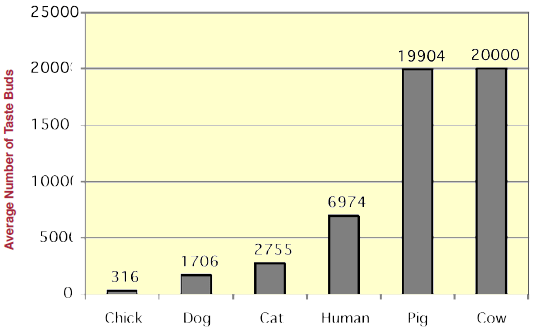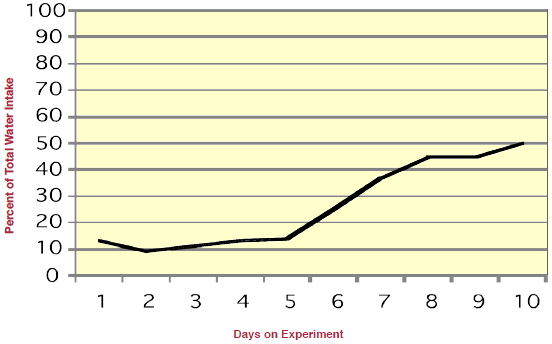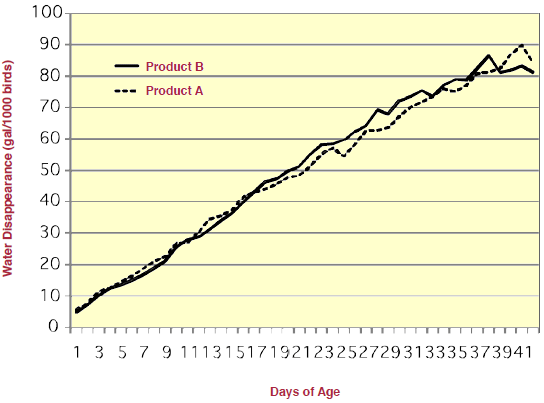



How Does Taste Influence Water Consumption in Broilers?
A review of our understanding of the sense of taste in broiler chickens by F.T. Jones and S.E. Watkins from the University of Arkansas. They recommend monitoring water usage by the flock day-by-day so that problems can be solved before profits are lost. The article was published in Spring 2009 issue of the University's Avian Advice.

Background
Early studies suggest that birds are much more sensitive to flavours in water than in feed (Kare and Pick, 1960). This sensitivity to flavours in water may be due to the fact that birds consume almost twice as much water as feed. However, the issue of taste is much more complex than it may seem because humans perceive taste differently from many other animal species.
To illustrate this point, one researcher compared the responses of different animals to a sucrose (sugar) solution, and its equivalent in saccharine. Most humans said that both solutions are sweet and pleasant tasting and laboratory rats had a similar reaction. Calves drank much more of the sucrose than humans did but drank little of the saccharine. Chickens and dogs drank the sugar but found the saccharine very offensive. Cats did not respond to either of the solutions. The point of this illustration is humans cannot use our own sense of taste to predict how animals will respond (Kare, 1970).
Chickens, in fact, prefer water that is cold and slightly acid in taste rather than sweet (Kare, 1970). Although chicks have only a fraction of the number of taste buds found in other animals (Figure 1), birds have a well defined sense of taste and will reject certain flavours (Kare et al., 1957). In addition, the taste buds in chickens are in different locations to other animals. In humans, and many other animal species, most taste buds are on the tongue but in the chicken, taste buds are distributed primarily on the back part of the roof of the mouth, with only two to four per cent being located on the tongue (Ganchrow and Ganchrow, 1985). In fact, the taste buds in chickens are so far back in the mouth that by the time the bird can taste something, it is almost too late to change its mind about swallowing it (Kare, 1970). Yet, the sense of taste is more than just how feed or water feels in the mouth of the bird. The sense of taste is all the sensation a bird experiences after consumption.

Adapted from Roura et al, 2008
In general, the sense of taste guides an animal as to what it should eat. For example, chickens given a thiamin-deficient diet and offered two solutions, one with and one without thiamin, will choose to drink a solution containing thiamin. While humans perceive xylose as about 70 per cent as sweet as sucrose (sugar), chickens will drink little xylose, which has been found to cause cataracts in some bird species (Kare, 1970). These and similar choices suggest that taste is often the basis on which the bird seeks to meet its nutritional needs (Roura et al., 2008). However, the problem is still more complicated.
Water to humans is wet and tasteless but to birds, water has a distinct taste. Therefore, water in itself is a strong stimulus for the bird and flavours tested in water solutions are actually perceived by the bird as mixtures of flavours (Beidler, 1961; Kare, 1970; Gentle, 1985). Although flavour perceptions in many animals also involve the perception of odours, in birds odours in their immediate environment have little apparent effect.
Yet, temperature of water can be critical for birds. When presented with two choices of water, one at room temperature and the other a degree or two above their body temperature, birds will suffer from acute thirst rather than drink the warmer water. On the other hand, birds will readily consume water at temperatures close to freezing. This may be due to the fact that birds are well insulated with feathers, which protect them from the cold, but allow little or no means to dissipate excess body heat.
Practical Applications
The data in Figure 2 were collected by Kare et al., (1957), who tested acceptance of water containing various flavours by placing two chick watering jars in each pen. One jar contained untreated water and the other contained flavoured water. The researchers compared the amount of water consumed from the two jars to measure the acceptance or rejection of flavours by the birds. Some flavours (strawberry, alfalfa, nutmeg, honey, molasses, mushroom, and wild cherry) were rejected outright, while birds would drink certain other flavours (butter pecan, butterscotch, raisin, coconut, grenadine, oil of patchouli and colocynth pulp) sparingly at first, but gradually accept the flavour as illustrated by Figure 2.
Other than the novelty of knowing how flavoured water influences the taste of chickens, is there a practical application for this information? Absolutely. The taste of water due to either natural or added materials can dramatically influence consumption, particularly in young birds.

Adapted from Kare et al. 1957
Birds were given a choice of unflavoured water or water containing four parts per thousand butter pecan flavour. These data represent the percentage of flavoured water consumed.
The authors witnessed firsthand the effects of differences in water consumption in young birds at the University of Arkansas Applied Broiler Research Farm when they tried a different water acidifier (Figure 3). The three flocks grown on product B were lighter at settlement than previous flocks grown on product A. Yet, overall water consumption data for these flocks showed no difference. However, data for the first week showed lower water consumption for flocks grown on product B than product A and it took almost 21 days before the birds returned to consumption seen on product A. The authors say they were fortunate that we were raising a heavier bird and the additional time given to the birds to become acclimatised to product B allowed them to make up some performance by the time the birds went to market. However, growers raising lighter birds would not have the luxury of making up for poor early water and feed consumption.

How can Growers Identify Water Consumption Challenges?
If birds do not eat, they do not gain weight. Since feed and water consumption are closely correlated (one pound of feed consumed for approximately 1.67 pounds of water consumed), it is critical to pay attention to water consumption and head off problems before they start. As illustrated in Figures 2 and 3, when birds gradually accept water with certain flavours particularly early in the life of the flock, detection may be much more difficult but the losses can be just as real (Tabler, 2003). In view of this situation, the following suggestions are offered:
- Closely monitor water consumption, particularly early in the flock. Install meters in both the front and back of the house. Readings from these meters provide crucial information to determine if birds are properly spread through the house as well as determine if water lines are correctly adjusted. At about the same time each day, record water meter readings starting from day one of the flock. Identifying and solving water issues can more than pay for the cost of meters.
- Develop water usage patterns. Since water consumption will likely vary from farm to farm, develop average water consumption charts for your farm. Compare each flock’s consumption numbers with the average you have developed and pay particular attention early in the life of the flock.
- Be aware that not all water supplies and water additives are compatible with the bird’s taste. Pay close attention to water usage when trying new products to ensure that there is no decrease in water usage. Make a note of products that the birds appear to like due to increased consumption, which is not accompanied by flushing in the birds.
Conclusion
The factors influencing the sense of taste in birds are complex and not completely understood. However, it is clear that the taste of water can influence both feed and water consumption. By monitoring water usage and understanding what normal water usage patterns are for each day of age, producers can identify challenges and correct them before profits are lost.
References
Beidler, L.M. 1961. The chemical senses. Ann. Rev. Psychol. 12:363-388.
Ganchrow, D. and J.R. Ganchrow. 1985. Number and distribution of taste buds in the oral cavity of hatchling chicks. Physiol. Behav. 34(6):889-894.
Gentle, M.J. 1985. Sensory involvement in the control of food intake in poultry. Proc. Nutr. Soc. 44:313-321.
Kare, M.R. 1970. The chemical senses of birds. Bird Control Seminars Proceedings Accessed 3/24/09
Kare, M.R., R. Black and E.G. Allison. 1957. The sense of taste in the fowl. Poultry Sci. 36:129-138.
Kare, M.R. and H.L. Pick. 1960. The influence of the sense of taste on feed and fluid consumption. Poultry Sci. 39:697- 706.
Roura, E., B. Humphrey, G. Tedo and I. Ipharraguerre. 2008. Unfolding the codes of short-term feed appetence in farm and companion animals: A comparative oronasal nutrient sensing biology review. Can. J. Animal Sci. 88:535-558.
Tabler, G.T. 2003 Early feed intake and bird performance. Avian Advice 5:13-15








